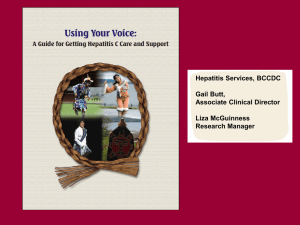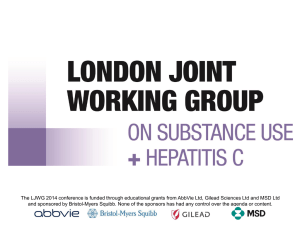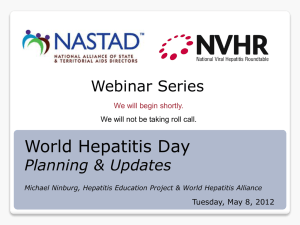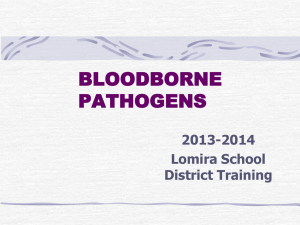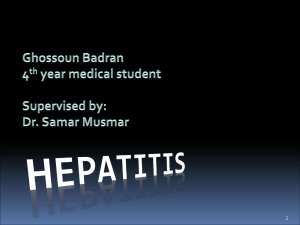Eamonn O`Moore LJWG 2014 - London Joint Working Group
advertisement
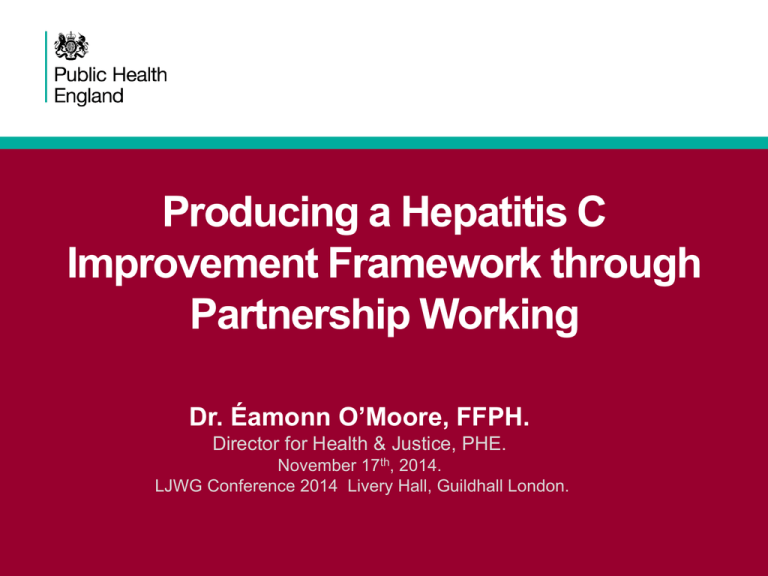
Producing a Hepatitis C Improvement Framework through Partnership Working Dr. Éamonn O’Moore, FFPH. Director for Health & Justice, PHE. November 17th, 2014. LJWG Conference 2014 Livery Hall, Guildhall London. 2 Hepatitis C Partnership Group • Multiagency group co-chaired by Prof. Paul Cosford, Director for Health Protection, PHE and Kate Davies OBE, Head of Public Health, Armed Forces, Health and Justice for NHS England; • Membership includes representatives from DH, The Hepatitis C Trust, NHS England Hepatobiliary and Pancreas CRG, The Hepatitis C Coalition, senior clinicians and public health specialists from PHE. • Aims of the Hepatitis C Partnership include joint actions across partner organisations to identify and address key challenges to improve diagnosis, treatment and care for people living with Hepatitis C virus infection and to reduce the risk of transmission of infection. • Agreed to develop a Five Year Hepatitis C Improvement Framework which is now in final draft pending sign-off following recent meeting on November 5. • Planned publication date January 2015. Presentation to Hepatitis C in London: Practical Steps to Elimination 17 Nov 2014 3 Hep C Improvement Framework • Hepatitis C is a curable infection. • The overarching goal of this framework is to eliminate hepatitis C as a significant public health concern in England through the collective action of all partner organisations. • This 5 year improvement framework is intended to establish the foundations of an active case-finding, prevention, diagnosis and treatment programme for that long-term aim. • In order to keep the improvement framework (and the Partnership Board) focussed on this, the following ‘vision and mission’ has been agreed. Presentation to Hepatitis C in London: Practical Steps to Elimination 17 Nov 2014 4 Draft Vision and Mission Statement • All people at risk of hepatitis C virus to have access to testing and if infected, access to appropriate treatment and care, which in the majority of cases will clear the virus. • The long-term outcome aimed for is to reduce hepatitis C transmission, hepatitis C-related serious liver disease, liver cancer and the resulting premature mortality thus laying the groundwork for eventual elimination of hepatitis C as a serious public health concern in England. Presentation to Hepatitis C in London: Practical Steps to Elimination 17 Nov 2014 5 Two draft ambitions for the Framework: • The following was proposed at a meeting of the Hepatitis C Partnership Group on November 5 following review of the latest draft: • Hospital admissions for HCV-related ESLD to remain stable over the next 10 years and to be falling significantly by 2025; • Prevalence of chronic infection in PWID reduced by a quarter (from ~ 40% to 30%) over next 10 years. Presentation to Hepatitis C in London: Practical Steps to Elimination 17 Nov 2014 6 Framework topic: People who inject drugs • People who inject drugs (PWIDs) and share needles are at a significantly higher risk of acquiring HCV. • Drug treatment services are an important location for offering tests and providing health promotion messages to prevent transmission as well as being an entry point on to a care pathway; • PWIDs seeking help for their drugrelated problems through drug treatment services should also be offered a hepatitis C test as part of BBV testing with pre- and posttest counselling. Presentation to Hepatitis C in London: Practical Steps to Elimination 17 Nov 2014 7 PWID cont’d: Objectives & Measures Objective Measure Hepatitis C & other BBV testing is offered to all PWIDs attending drug treatment services as part of an opt-out system, and those testing negative should be re-offered tests as appropriate. Proportion and number of people in contact with drug treatment services offered and accept hepatitis C (as part of BBV) testing (through UAM and NDTMS). HCV treatment services to be commissioned to deliver in non-hospitalbased settings such as substance use services or other community settings. Proportion of PWIDs offered hepatitis C treatment who are seen in a non-acute setting. Improve the effectiveness of Hepatitis C prevention messages to PWIDs Attitudes and behaviour among PWID through unlinked anonymous monitoring (UAM) survey. Presentation to Hepatitis C in London: Practical Steps to Elimination 17 Nov 2014 8 Framework Topic: Testing & diagnosis • The offer and uptake of testing and use of appropriate tests for diagnosis of the infection is the cornerstone of improving services for people with HCV • Improved access to targeted testing as recommended by NICE, in several settings, including primary care, GUM, drug and needle exchange services and prisons and other PPDs is needed along with greater consistency in reporting confirmatory diagnostic results. • Dried Blood Spot Testing is good vehicle to improve uptake. Presentation to Hepatitis C in London: Practical Steps to Elimination 17 Nov 2014 9 Testing & Dx: Objectives & Measures Objectives Increase the offer and uptake of testing and diagnosis among population groups at risk of infection, in line with current evidence and national guidelines. Measures Numbers of tests offered and proportion positive by setting; Key actions include ensuring HCV antibody test is always confirmed with PCR test; people diagnosed with hepatitis C are assessed for specialist care according to guidelines; commissioners of primary care, sexual health, drug treatment and prison health services ensure HCV/BBV testing and referral in service specifications. Presentation to Hepatitis C in London: Practical Steps to Elimination 17 Nov 2014 10 Framework Topic: Needle & syringe programmes (NSPs) • NSPs central to public health programmes to reduce transmission of BBVs since HIV epidemic. • Critical point of contact with those at risk of infection, known to be infected and those not yet ready for treatment . • Investment needs to be maintained to stop BBV prevalence rising and to prevent infection outbreaks. • Commissioners and service providers should assess and respond to the needs of all people who do not perceive themselves to be PWIDs – such as people who use image and performance enhancing drugs (IPEDs). Presentation to Hepatitis C in London: Practical Steps to Elimination 17 Nov 2014 11 NSPs: Objectives & Measures Objectives Ensure that needle and syringe programmes provide an appropriate range of services with sufficient coverage to meet local need and informed by current evidence and national guidelines; Measures Monitor a basket of measures from existing needle exchange collections Make better use of needle exchanges Numbers of tests offered and to increase engagement and testing; proportion positive by setting. Presentation to Social Justice consultation Windsor Castle June 4 2013 12 Framework Topic: Prisons & Secure Settings • Significant overlap of risk of incarceration with risk of HCV infection due to IDU; • Testing & treatment here improves health not only of prisoners but those in ‘at or near prison social networks’ in wider community- community dividend. • Evidence of the effectiveness of treating hepatitis C in a prison setting including in-reach and outreach models; introduction of opt-out testing policy via Pathfinder Prisons is already leading to increased coverage of testing even beyond those prisons. Presentation to Hepatitis C in London: Practical Steps to Elimination 17 Nov 2014 13 Prisons & Secure Settings: Objectives & Measures Objectives Measures The offer of blood-borne virus (BBV) optout testing to be the norm at the point of the healthcare/screening assessment in secure & detained settings; Number and proportion of people offered BBV in secure & detained settings (H-JIPs) Opt-out testing process to be completed within 2 weeks of arrival, including pre and post-test counselling. Health & Justice Indicators of Performance (H-JIPs) Increase the proportion of people with HCV in secure & detained settings to be on a treatment care pathway. Proportion of people diagnosed with HCV infection in a secure or detained setting on a care pathway Presentation to Hepatitis C in London: Practical Steps to Elimination 17 Nov 2014 14 Framework Topic: Treatment • Treating hepatitis C infection has clear benefits for the person including avoidance of severe illness and early mortality; • Treatment also avoids associated healthcare costs of treating ESLD. • Treatment and cure also protects the community against further transmission by reducing the pool of infection : ‘treatment as prevention’; • However, currently only 3% of people living with HCV are treated. Presentation to Hepatitis C in London: Practical Steps to Elimination 17 Nov 2014 15 Treatment: Objectives & Measures. Objectives Measures Ensure everyone diagnosed with HCV Proportion of people diagnosed with is on a care pathway with access to HCV infection on a structured care appropriate treatment; pathway New hepatitis C treatments are emerging onto the market which are simpler to take, have less side effects and require less monitoring (and so can facilitate a shift to treatment in community settings), but are very expensive. NHS England is committed to assessing which and how these new drugs could be introduced in a managed way and reduce financial risk to the health & social care system as a whole. NHS England has set up a task & finish group to assess the costs and benefits in the short, medium and long-term and will complete its work in early 2015. Presentation to Hepatitis C in London: Practical Steps to Elimination 17 Nov 2014 16 Framework Topic: Workforce • Creation of a learning and development framework to provide an hepatitis C competent and able workforce, with specific sections relevant to different healthcare professionals (i.e. drug service professionals, GPs, and pharmacy staff and so on) • Create an inventory of training and educational resources available for different professionals e.g. RCGP emodule for GPs. Presentation to Hepatitis C in London: Practical Steps to Elimination 17 Nov 2014 17 Workforce: Objectives & Measures Objectives A learning and development framework to provide an hepatitis C competent and able workforce, with specific sections relevant to different healthcare professionals (i.e. drug service professionals, GPs, and pharmacy staff etc.) Measures Publication of the learning & development framework Presentation to Hepatitis C in London: Practical Steps to Elimination 17 Nov 2014 18 Framework Topic: Data & intelligence • Inclusion of hepatitis C indicators on national policy documents such as the Public Health Outcomes Framework prioritises the condition, draws resources and galvanises action towards achieving the targets. • Evidence of impact and cost-effectiveness of prevention, diagnosis and treatment strategies, are critical in advocating for new interventions or approaches. • Monitoring of hepatitis C strategies should occur at all levels, national and local, and by all commissioners, including local authority (Health and Wellbeing Boards), • PHE’s annual report on Hepatitis C in the UK will track progress against the objectives and actions in the framework by reporting on included indicators. Presentation to Hepatitis C in London: Practical Steps to Elimination 17 Nov 2014 19 Intelligence & Data: Objectives & Measures Objectives Improve the quality of data and intelligence on the outcomes and impact of improved hepatitis C prevention and treatment services; Measures HCV-related data sources increase and improve in terms of coverage, validity, reliability and timeliness. Presentation to Hepatitis C in London: Practical Steps to Elimination 17 Nov 2014 20 Improvement Framework – Next steps • Tackling BBVs is a shared partnership public health priority; • Framework will be published in January 2015; • Implementation expected to commence from April 2015 onwards; • HCV Partnership Board will monitor progress and provide update reports to the PH tripartite governance system. • It is intended that the Framework will be reviewed annually enabling the re-prioritisation and the setting of new time-frames for the delivery of actions. Presentation to Hepatitis C in London: Practical Steps to Elimination 17 Nov 2014 21 Engagement Events: HCV Action & PHE • Awareness raising and engagement events are being planned for delivery during 2015 to raise awareness of hepatitis C across England, particularly where prioritisation is poor and prevalence is high, and encouraging health professionals to work together towards eliminating hepatitis C in their area; • Attendees at the events would include local health professionals (working in drug services, primary care, secondary care and prison healthcare); commissioning representatives from local CCGs and Local Authorities; and laboratory, NHS England specialised commissioning, prison healthcare and PHE centre staff and patient voice representatives. Presentation to Hepatitis C in London: Practical Steps to Elimination 17 Nov 2014
